Related Research Articles

The Browning Hi-Power is a single-action, semi-automatic pistol available in the 9×19mm Parabellum and .40 S&W calibers. It was based on a design by American firearms inventor John Browning, and completed by Dieudonné Saive at FN Herstal. Browning died in 1926, several years before the design was finalized. FN Herstal named it the "High Power" in allusion to the 13-round magazine capacity, almost twice that of other designs at the time, such as the Luger or Colt M1911.
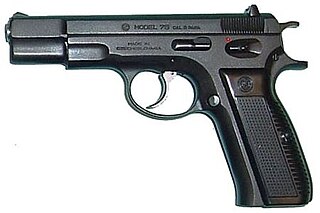
The CZ 75 is a semi-automatic pistol made by Czech firearm manufacturer ČZUB. First introduced in 1975, it is one of the original "wonder nines" and features a staggered-column magazine, all-steel construction, and a hammer forged barrel. It is widely distributed throughout the world and is the most common handgun in the Czech Republic.

The Walther PP series pistols are blowback-operated semi-automatic pistols, developed by the German arms manufacturer Carl Walther GmbH Sportwaffen.

The SIG Sauer P220 is a semi-automatic pistol. Designed in 1975 by the SIG Arms AG division of Schweizerische Industrie Gesellschaft, and produced by J. P. Sauer & Sohn, in Eckernförde; it is currently manufactured by both SIG Sauer companies: SIG Sauer GMBH, of Eckernförde, Germany; and SIG Sauer, Inc., of New Hampshire, United States.
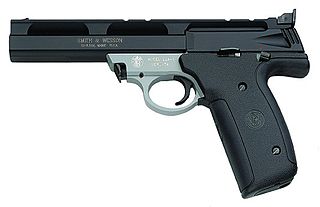
The Smith & Wesson Model 22A is a semi-automatic pistol that was manufactured in Houlton, Maine. The 22A is a full-size pistol with an aluminum alloy frame. The steel barrel has an integrated Weaver style rail.

The Beretta M1951 is a 9×19mm semi-automatic pistol developed during the late 1940s and early 1950s by Pietro Beretta S.p.A. of Italy. The pistol was produced strictly for military use and was introduced into service with the Italian Armed Forces and other Italian security forces as the Modello 1951 (M1951), replacing the Modello 1934 pistol chambered for the 9×17mm Short cartridge.

The Walther P38 is a 9 mm semi-automatic pistol that was developed by Carl Walther GmbH as the service pistol of the Wehrmacht at the beginning of World War II. It was intended to replace the comparatively complex and expensive to produce Luger P08. Moving the production lines to the more easily mass producible P38 once World War II started took longer than expected, leading to the P08 remaining in production until September 1942, and pre-existing copies remained in service until the end of the war.

The Heckler & KochP7 is a German 9×19mm semi-automatic pistol designed by Helmut Weldle and produced from 1979 to 2008 by Heckler & Koch GmbH (H&K). It was revealed to the public for the first time in 1976 as the PSP. The P7M13, a variant of the P7 with a double-stack magazine, was produced until 2000, and was unsuccessfully submitted to the U.S. Army XM9 pistol trials as a replacement for the M1911 pistol.

The Ruger P series is a line of centerfire semi-automatic pistols made by Sturm, Ruger & Company produced from 1985 to 2013. The P-series pistols were designed for military, police, civilian and recreational use. The designs are largely based on the Browning action found in the M1911 pistol, but with minor variations, generally related to the safety mechanism and the barrel-camblock interface. Reviews have considered them rugged, reliable, and strong, though this strength comes at the price of bulk and a blocky appearance.

The Thunder 9 is a full-size semi-automatic handgun manufactured by Bersa at the Ramos Mejia production plant in Argentina. It is also sold under the name Firestorm or FS 9.

In American English, a pocket pistol is any small, pocket-sized semi-automatic pistol, and is suitable for concealed carry in a pocket or similar space.

The Walther TP and TPH handguns are extremely compact double-action lightweight semi-automatic pistols in .22 Long Rifle and .25 ACP calibers. Pistols in this size range are sometimes referred to as pocket pistols, or Taschen Pistolen in German. The TP was produced by Walther from 1961-1971 and the improved TPH has been produced continuously since 1968. Models have been produced in Germany and in the US.
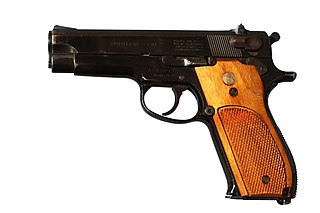
The Smith & Wesson Model 39 is a semi-automatic pistol developed for the United States Army service pistol trials of 1954. After the Army abandoned its search for a new pistol, the Model 39 went on the civilian market in 1955 and was the first of Smith & Wesson's first generation semi-automatic pistols. A modified version saw limited use with Naval Special Warfare units as the Mk 22 Mod 0.

The Walther PPS is a semi-automatic pistol developed by the German company Carl Walther GmbH Sportwaffen of Ulm for concealed carry for civilians and plainclothes law enforcement personnel. It is available in either 9×19mm Parabellum or .40 S&W chamberings. It was first shown in 2007 at the IWA & OutdoorClassics and is a slim polymer framed weapon of similar size to the Walther PPK pistol. The PPS is however technically much more based on the Walther P99 pistol.

The Walther PPQ is a semi-automatic pistol developed by the German company Carl Walther GmbH Sportwaffen of Ulm for law enforcement, security forces and the civilian shooting market as a development of the Walther P99. It is available in 9×19mm Parabellum, 9×21mm, .40 S&W, and .45 ACP chamberings.
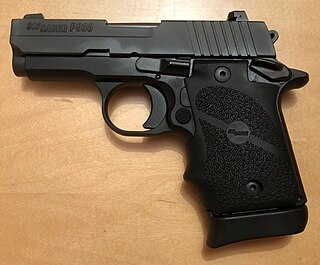
The SIG Sauer P938 is a subcompact single-action pistol chambered for the 9×19mm Parabellum cartridge, manufactured by SIG Sauer and introduced at the 2011 SHOT Show. A variant chambered for .22 Long Rifle was introduced in 2014.

The Beretta 70 is a magazine-fed, single-action semi-automatic pistol series designed and produced by Beretta of Italy, which replaced the earlier 7.65mm Beretta M1935 pistol. Some pistols in this series were also marketed as the Falcon, New Puma, New Sable, Jaguar, and Cougar. The gun is notable for its appearances in film, and is also the first compact Beretta pistol to feature several improvements commonly found in Beretta pistols for the rest of the century.

The Ruger SR22 or SR22P is a compact semi-automatic pistol manufactured by Sturm, Ruger & Co., chambered for the .22 Long Rifle rimfire cartridge. The SR22 is mainly targeted at plinking and competition shooting.
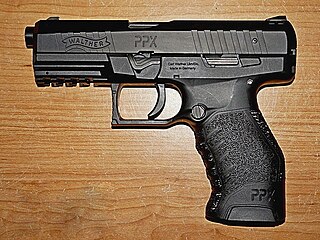
The Walther PPX and the Walther Creed semi-automatic pistols were developed by the German company Carl Walther GmbH Sportwaffen of Ulm as low-cost duty handguns. The PPX was available in 9×19mm Parabellum and .40 S&W. Its successor, the Creed, was available only in 9mm.

The Walther Model 8 was a 6.35mm single-action pocket pistol manufactured by Carl Walther CmbH between 1920 and 1940. It was fed by an 8-round magazine and chambered in .25 ACP. The Model 8 is a blowback pistol with a concealed hammer and has several design features that were innovative for Walther, including fewer parts and an easier disassembly.